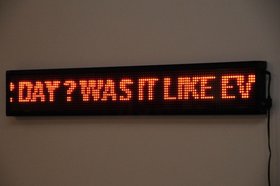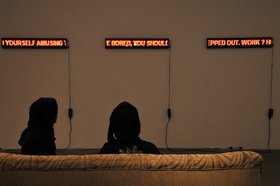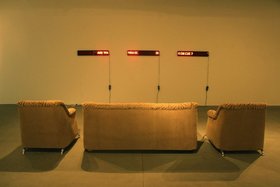Interviews
Auto-Connections
UBIK in conversation with Isabella Ellaheh Hughes
Kerala-born artist UBIK (real name Vivek) entered the Dubai art scene four years ago, gaining attention for a series of pen and marker drawings. Since 2010, the Dubai-based artist, who cites American pop culture and artist John Baldessari as his 'biggest influences', has notably shifted his practice to encompass text-based, conceptual works that encourage viewer interaction on various levels, ranging from self-reflection to direct action. This shift has resulted in work that tends to offer sarcastic yet introspective commentary on societal norms, political ideologies and human behaviour, whilst exploring different modes of production and pushing new relationships between text and materials as diverse as balloons, fortune cookies, LED tickers, cloth flags and wooden plaques – the latter resembling both gravestones and celebratory plaques.
In this interview with curator and critic Isabella Ellaheh Hughes, UBIK discusses his experiences as an emerging artist in Dubai and the current direction of his practice, as seen in his recent installation Autosuggestion (2012), which forms part of A Most Precarious Relationship: Artists, Audiences and Interactive Art in the Emirates at the Maraya Art Centre in Sharjah.
Isabella Ellaheh Hughes: What inspires your practice most?
UBIK: I think what really inspires me now is how this new world order is shaping up. I'm fascinated with semantics and the language of propaganda. But then again, I'm constantly researching and reading about anything and everything. It's a never-ending session, really.
IEH: Where do you see your practice developing?
U: I'm trying to steer my practice into a more fluid, conceptual direction and to expand into different mediums – most of the time into mediums that are totally alien in terms of familiarity of working with them. I'm just trying to experiment a lot now. I'm currently obsessed with developing and working on projects that tend to have an absurdist element to them. I think it's about locating the fine balance between doing things that could sell in a commercial space and doing interactive, experience-based projects. I now think, 'Well, if I've thought about the concept, no matter how absurd, why not go ahead and try to get it commissioned or developed?' There's not much to lose. I'm trying not to restrict myself. For the past year, I've felt like I was in college a bit, just experimenting. My new direction – conceptual, primarily text-based, as opposed to drawing – is more immediate. I just feel like drawing is dead, for me it's dead; I don't feel it anymore. Aesthetics are dead. I can't make things with my hands, I'm not technically skilled at making videos or complex media work, like artist James Clar, for example. I keep sending my work to production, or relying on commercial production. I know I'm outsourcing, but I also don't really have a studio, I live in a one-bedroom apartment. I want to figure out how to use new media art and programming, like James. We've hung out a lot; he's a good friend and an influence.
IEH: A lot of the work produced in the region heavily references ethnic and nationalistic ties, identity and cultural confusion, which your work, especially your most recent work, is essentially devoid of. Why have you decided, as an Indian artist working in an Arab country, to forgo exploring these themes?
U: It's surprising. A lot of people keep asking me if I'm patriotic – I'm one of the few Indians that doesn't like cricket! Sure, I have nostalgia for my roots, but I don't see my life as part of a diaspora. It's not like my family had to move here. I operate between both places. Living in India, the arts were just not there when I was growing up, and everything I saw there was too Indian, I didn't like the aesthetics. Even back then, I was more interested in wall posters, roads signs, mobile texts, the accidental spelling mistakes Indians make in signboards; those kinds of things inspired me, not any particular Indian style. A lot of my influences are American, American pop culture, actually. But even without addressing personal identity and culture, my work doesn't alienate. The piece I just had at the Beirut Art Fair in Sabrina Amrani's booth, for instance, is a plaque that reads: 'And they lived happily ever after after taxes'. Even if people didn't really understand it, they still got it. When I write, I don't want it to be too fancy, I want everyone to get it, see an image in their heads.
IEH: Interactive elements feature prominently in many of the works you have developed over the last year-and-a-half, which you have exhibited in Dubai – I wonder if you could speak about this?
U: I think this was quite a natural turn. I was getting bored with doing works that were static. I wanted to create an experiential aspect for my works as opposed to just hanging them on a gallery wall. I make it a point to encourage the audience to engage with my works and I'm really curious to see how they emote when they are around my works. There's something weird in me that wants to push the audience to the limit, to take them out of their comfort zone – but I prefer to just give them the necessary tools to do so. I like to leave the option and the level of interactivity open to the viewer to decide, as opposed to setting the limits of engagement.
IEH: In the Maraya group show, whose theme is interactivity, you've really pushed the idea of what 'interactive art' means. Instead of creating something physically interactive, your piece, Autosuggestion (2012) comprised out of furniture and LED tickers, is much more subtle and about mental rather than physical interaction. Are you trying to broaden the definition of interactive art with this work?
U: I wanted to do a piece that would calm the visitors in the space. I wanted the piece to make them comfortable and then let them reflect on what they see, as opposed to giving them a ready-made installation, and all that would be required of them was to interact with it in terms of touch or other ways. As I mentioned above, I'm more interested in seeing how visitors react to my work without any instructions. I didn't want it to be interactive on a physical level; I was consciously trying to make it mentally interactive, where someone had to make the effort to make it interactive, it wasn't just given to them.
The text in the piece was inspired by a recent experience in India; I was in a coffee shop, right after Art Dubai, and I was thinking what the hell to pitch when this lady gave me a leaflet, a classic Indian leaflet that read: 'Are you earning what you're worth? Do you want to work from home?'. And it just clicked. I started researching the notion of self-help and writing a lot. A lot of my work is like that, random, automatic writing. My artist's statement on the piece really explains this better:
Autosuggestion is a site-specific installation that aims to explore the notions of consumerist guilt and capitalistic shame. The installation urges the audience to sit down and read a piece of concrete poetry and reflect on their financial/personal wellbeing. This interactive installation is meant to be straightforward. The audience is given the choice to sit down, read poetry and think about how much they are really worth. What I want them to do is: relax and take some time to just reflect on the space, the piece and give in to a sense of resignation, which might transcend into a sense of blissful acceptance of their respective fate. I'm interested in the 'audience' making that extra effort to make the piece 'interactive' for them, as opposed to the artwork being a readymade, interactive piece. The poetry aspect of the installation revolves around existential dilemmas associated with our respective capitalistic tendencies and lifestyles.
IEH: What are some of the challenges facing an emerging artist like yourself in the UAE?
U: At this stage in my career, I can't afford to cover my own production. Sure, I can go ahead and get stuff done cheaply. But there's a limit to the scale and nature of the projects I can do, especially when it comes to conceptual art. You really can't be a full-time artist in this country due to the visa laws, but these are the challenges that everyone knows about and debates endlessly, without any proper conclusion. It's something that really makes no sense to me, which is why I prefer just trying to find avenues to go down, hustle my concepts and see if I can realise them.
IEH: It's been a busy year for you, with participation in SIKKA, Art Dubai Projects, a solo in Madrid, the Beirut Art Fair, the Maraya show, the Lawrie Shabibi summer group show – what more can you be doing before this year is up?
U: I've got a solo project called A Little Help from my Friends at Pavilion Downtown Dubai, but really I am focusing on residencies.
UBIK is an artist based in Dubai, UAE. His works experiments with a variety of mediums, without restriction to a specific genre. The core of UBIK's work revolves around appropriation and manipulation of text and images, and the exploration / exploitation of everyday situations. UBIK crafts his work to be conceptual, not in the form of technicality but rather its reactionary possibilities.
UBIK has had a variety of solo exhibitions at local and International galleries, including: TheJam Jar (2009), Shelter (2010), Traffic (2011) and Sabrina Amrani (2012). His work has also been exhibited in Satellite, as part of the Satellite Broadcast series (2011). UBIK has been included in THE STATE series, curated by Rami Farook at Traffic and showcased new projects for Art Dubai (2012) and SIKKA Art Fair (2012). His works have also been featured in group shows at Lawrie Shabibi gallery (2012) and Maraya Art Centre (2012).








